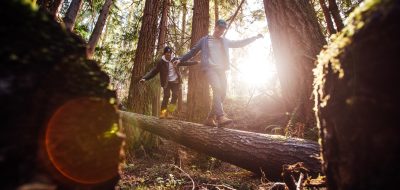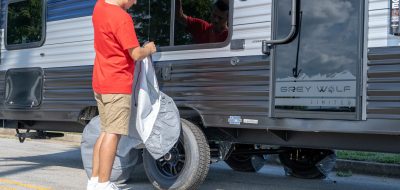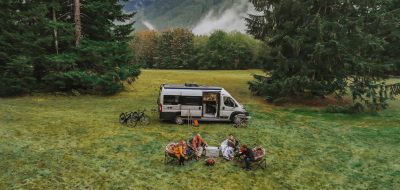Today I want to talk to you about something many of us fear, Carbon Monoxide. This is the time of year when many of us start having to think about our furnaces, both in the camper and in the home. When that furnace comes on, if it isn’t working properly, you maybe exposed to Carbon Monoxide. I am sure you have all heard of the sad stories of people that have died from carbon monoxide, and it is no accident that these deaths occur this time of year.
But what is Carbon Monoxide, and why is it dangerous? Well, to be honest, it is nothing more than one carbon atom bonded to one oxygen atom. Very similar to what we exhale when we breath, which is Carbon Dioxide ( one carbon atom and two oxygen atoms). Carbon, oxygen and Hydrogen are often known as the building blocks of life. They are in almost everything you eat, breath or see. Heck, Water is H2O; air contains all three as does sugar! What makes Carbon Monoxide so deadly is its property of seeking bonds with other chemicals. Most importantly, it loves to bond with the Hemoglobin in the blood. In fact, it bonds many, many times more readily than oxygen. That is the root of the problem; once it bonds to the hemoglobin it doesn’t want to let go, and it replaces oxygen in the blood stream. No oxygen in the blood stream means there is no oxygen in your cells to keep them alive. Once carbon monoxide bonds to the hemoglobin, it can stay there till the blood cell dies in about 6 weeks, making that blood cell useless for carrying oxygen to things like your brain!
But where does carbon monoxide come from? Well, mostly it comes from incomplete combustion. Or to put it in easier terms — when something isn’t burning cleanly and completely, it produces carbon monoxide. One of the most famous things that doesn’t burn cleanly of course is your car; remember you mother telling you not to run the car in the garage or it would kill you? Well, your mother was right, (didn’t she always tell you she was always right?); the car burns the gas (carbon, hydrogen and oxygen mainly), and one of the by products is carbon monoxide. When you have your propane stove in your camper burning, you notice it burns with a pretty blue flame? That is complete combustion, the propane burns with the oxygen and produces heat and very, very minor amounts of carbon dioxide, carbon monoxide and water vapor. Now that same flame on your stove, if it isn’t burning properly, will turn yellow and/or orange. Now it is putting off much, much more carbon monoxide, and in a tightly sealed area will sooner or later raise the level of carbon monoxide. But that is a pretty small flame and a camper is not sealed that effectively. On the other hand, the flame used in your furnace and water heater are much larger, and if not burning properly produce many times the amount of carbon monoxide. This is when you run into problems.
So, what can you do to protect yourself? First off, check to see is your carbon monoxide detector is working properly. Read the owners manual and learn how to test and clean it properly. If it is over 5 to 7 years old, I would recommend getting a new one; older carbon monoxide detectors will give false alarms or no alarms. So replacing them is cheap life insurance. Second, make sure that your furnace, water heater and Oven are working properly; make sure the flue is open and there are no debris or wasp nests or anything else blocking them. You can blow air through the flue (if they have one) and make sure they are clean and open, then make sure your burners are adjusted properly; I have to say you should have them checked by a professional just to be safe, but remember clean, all blue flames are good, the more yellow and orange the worse it is. Usually the biggest problem is air movement, either taking the burnt gases away or getting oxygen to the burner. And opening the cover plate lets more oxygen in and can hide problems sometimes, but looking will give you some idea if things aren’t burning well. Just don’t think that “OH it worked last year so it will be fine THIS year”. Also remember to check your generator and its placement. The exhaust from a generator being run for hours on end produces carbon monoxide. Earlier this year there was a report of a tent camper dying from generator exhaust while camping at a NASCAR event, surrounded by other large campers and the like, which contained the deadly gas. So watch where the exhaust goes and your running hours too.
Now what to look out for. Even if you have checked your camper out and have put a new detector in, you still could have problems because carbon monoxide is colorless, odorless and tasteless. Most of the time carbon monoxide takes a while to build up and so often you don’t realize what is happening. But most of the time you will be worse over night or when inside for long periods of time. You will start to have headaches, feel lethargic, nausea and very weak. You might notice your fingernail beds and lips turning bluish and in late stages cherry red, also in the late stages there will be vomiting and unresponsiveness. If you think you or others have been exposed to high levels of carbon monoxide…. GET OUT of where you are at, into the fresh air, call for fire and EMS. Most fire companies will have portable CO detectors and, if you leave things the same, will be able to give you a exposure level from inside the camper. EMS will treat you with high flow oxygen and, if your carbon monoxide levels are high enough, advanced treatment will be needed. Once again the very young and the very old are more likely to have problems as well as those with cardiac and lung problems.
Remember to check your unit and watch for signs and symptoms, so you can protect your loved ones from this silent killer.
Your Obedient Servant,
Gary Smith, Jr.






Caravan wise
Don’t you think that there is something fundamentally wrong with the design of heaters and furnaces if there are any circumstances where they can pump carbon monoxide into the living quarters of your RV. It seems to me that it should not be beyond the wit of man to design a situation where the combustion happens outside the body of the RV but the heat is released inside. If burners that had the possibility of passing carbon monoxide into the body of an RV were banned someone would very quickly solve this problem. We shouldn’t have to rely on good maintenance and alarms to keep safe.
Jeff
Every house and apartment should be equipped with at least one CO detector on each floor. Cheapest life insurance you’ll ever get. If you buy one make sure you get one that uses grid power and has a BATTERY backup system! Its really scary that C0 poisoning has the same symptoms as a common flu, you might be in danger and just go to bed thinking you need rest.. I got this one for my house and i highly recommend anyone to do the same http://www.digitalcarbonmonoxidealarms.com/
Earl
We camp out in the woods where somtimes we have no electricity, and sometimes it gets a little cool at noght.
We have a single burner vent free heater that we use in our home and and it is safe to use in a single room or a large area.
We need to know if anyone has use one of theese heaters in a camper and if it is safe to use or should be safe to use in a camper.
If anyone should know please e-mail me with a ressponce to my question.
Charles
Hello,
I consider myself a smart man…LOL…how does one test a CO2 alarm?..I spent alot of years on a Heavy Rescue Company but smoke detectors were the only thing then……now their are these…also my detector is about 12 -16 inches off the floor built into the unit…..is it safe for my kids to play on the floor?…especialy my 9 month old…who sometimes takes a nap…my thinking is this…does the level have to reach the detector or will it sound off at a predetermined level regardless of reaching the unit!
Thank you
Gary Smith, Jr.
Stan I see nothing wrong with running your furnace in your camper over night as long as it is maintained well and cleaned and checked at least yearly (before the heating season.)
In fact I do it in my camper. I am paying for a furnace … it should be manufactured so that I can use it safely to keep myself comfortable. Every dealer and manufacturer, that I have talked to has no problem with you using your furnace overnight.
That being said, a carbon monoxide detector properly maintained and tested is very cheap insurance against any problems.
And Tony is right, even in homes you should check your furnace. In the next few weeks in Pennsylvania, I am sure we (EMS and Fire) will have several calls either for CO poisoning or for CO detectors going off, as the heating season starts. The people who have not maintained and checked their furnaces will be made aware of the fact that they should do so. Lets just hope and pray that none of them are fatal or seriously damaging.
Hope this helps,
Gary Smith, Jr.
Tony Cornett
Stan… I’m sure Gary will chime in here to but my feeling as a firefighter of 33 years is that if you maintain your unit and have the appropriate safety inspection done annually and also make sure you have a properly functioning Co detector I see no problem. The same condition exists in conventional homes with wall furnaces and others. We don’t turn off our furnaces at home do we? We should not have to in our RV’s either as long as I stated above. A properly operating and properly vented furnace should be no problem, but as mentioned a carbon monoxide (CO) detector is a must! As Gary said is a silent killer and I have even lost 2 family members to CO poisoning and responded to many incidents throughput my career. Play it safe, get your unit inspected and tested annually. another big issue is making sure your vent on the side of your unit is NOT blocked with hornets nests etc to allow proper venting and also reduce the possibility of fire.
Thanks for the article Gary!
Stan Burns
I have read that one should not leave the rv furnace running as they sleep overnight. What are your thoughts on this?
Thanks, Stan B